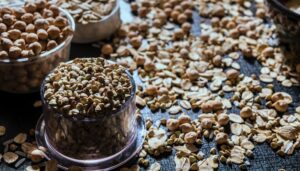
Puddings are delightful desserts enjoyed by people of all ages. However, it can be frustrating when your pudding doesn’t set as expected. Whether you are a novice or experienced in the kitchen, sometimes the process can go awry. In this article, we will explore various troubleshooting tips and techniques to fix pudding that didn’t set properly, ensuring you achieve the perfect, velvety consistency in your favorite dessert.
Setting The Pudding: Troubleshooting Tips
Puddings are a delightful treat loved by many, but sometimes they may not set as expected. Achieving that delicate, silky smooth consistency can be a challenge. In this section, we will explore some effective ways to fix pudding that didn’t set properly.
1. Utilize Cornstarch
Cornstarch is an excellent thickening agent for custard-style puddings. If your pudding contains eggs, flour, or cornflour but is still too runny, cornstarch can come to the rescue. However, it’s crucial to add cornstarch correctly to avoid lumps.
To use cornstarch, create a smooth slurry by mixing a spoonful or two with a small amount of cold water. Then add the slurry to your heated pudding mix and stir until it starts to thicken. Allow the mixture to boil for a minute or two to activate the thickening properties of cornstarch.
2. Explore Other Starches
Various starches, such as tapioca, all-purpose flour, and custard powder, can also help thicken puddings. Like cornstarch, they need to be heated and cooked to reach their full thickening potential. Keep in mind that the pudding may appear thin initially, but it will thicken further as it cools.
3. Consider Arrowroot Flour
If you prefer an alternative to cornstarch or have gluten concerns, arrowroot flour is an excellent option. It works well in homemade puddings that contain eggs. Like other starches, arrowroot flour needs to be heated to the gelatinization point.
After adding arrowroot to the pudding, gently heat the mixture until it thickens. However, when combined with dairy products, arrowroot may develop a slightly slimy texture.
4. Add Instant Pudding Mix
For a convenient and quick solution, consider using instant pudding mix to thicken your pudding. It doesn’t require additional heating and can be directly incorporated into the existing pudding.
Choose an instant pudding flavor that complements your pudding and mix it in without creating a slurry. The instant pudding will introduce extra thickening agents to the mix, enhancing the consistency. You can find various flavors like vanilla, caramel, strawberry, and chocolate.
Preparing the perfect pudding requires some experimentation and attention to detail. By using the right thickening agents like cornstarch, arrowroot, or instant pudding mix, you can easily fix pudding that didn’t set as desired. Remember to follow the correct procedures to avoid lumps and achieve a velvety texture in your delightful dessert.
Understanding the Common Causes
Before we dive into the solutions, it’s essential to understand why puddings may fail to set. Several factors can contribute to this issue, such as incorrect measurements, cooking time, temperature, or the choice of ingredients. Identifying the root cause will help you determine the best approach to fix your pudding.
Checking the Ingredients and Measurements
The first step is to review your recipe and double-check the ingredients and their measurements. Using the wrong type of milk, sugar, or thickener can lead to undesirable results. Make sure you are using the exact amounts specified in the recipe to achieve the intended consistency.
Adjusting Cooking Time and Temperature
Cooking time and temperature play a crucial role in the pudding-setting process. If you cooked the pudding for too long or at too high a temperature, it might not set properly. Conversely, undercooking can leave your pudding runny. Finding the right balance is key to success.
The Cornstarch Technique
Cornstarch is a common thickening agent used in pudding recipes. If your pudding hasn’t set, you can try dissolving an additional teaspoon of cornstarch in a little cold milk and then gently stirring it into the warm pudding. Bring it to a brief boil while stirring continuously until it thickens.
The Egg Yolk Method
For custard-based puddings, the egg yolk technique can work wonders. Mix one or two egg yolks with a small amount of warm milk, then gradually add it to the main mixture while stirring. Cook the pudding for a few more minutes to activate the thickening power of egg yolks.
Utilizing Gelatin
Gelatin can also be an excellent fix for a runny pudding. Prepare gelatin according to the package instructions and let it cool slightly. Gradually stir the gelatin into the pudding mixture and refrigerate until it sets perfectly.
Cooling and Chilling
Sometimes, patience is the key. Let your pudding cool at room temperature for a while before refrigerating it. This gradual cooling process can enhance its setting properties. Chill the pudding for at least a few hours or overnight for the best results.
Avoiding Over-Mixing
Over-mixing can lead to a runny pudding, especially in recipes with cornstarch or gelatin. Once you add these ingredients, stir gently just until they are fully incorporated. Avoid vigorous stirring, which can break down the structure and prevent proper setting.
Straining the Pudding
If you encounter lumps in your pudding, you can strain it through a fine-mesh sieve to achieve a smooth and silky texture. This step can also help improve the overall consistency.
Conclusion
In conclusion, making the perfect pudding involves attention to detail, precision, and patience. If your pudding didn’t set as expected, don’t worry! By identifying the issue and applying the appropriate fix, you can turn your runny dessert into a delectable delight.
FAQs
1. Can I fix a pudding that hasn’t set even after refrigerating it overnight?
Yes, you can still fix a pudding that hasn’t set completely. Try using one of the techniques mentioned in this article, such as the cornstarch method or the egg yolk technique.
2. My pudding turned out too thick. How can I adjust the consistency?
If your pudding is too thick, you can add a small amount of milk or cream and gently stir it in until you achieve the desired consistency.
3. Is it essential to chill the pudding for several hours?
Chilling the pudding for a few hours or overnight allows it to set properly and enhances its flavor. However, if you’re in a hurry, you can speed up the process by placing the pudding in the freezer for a shorter duration.
4. Can I use agar-agar instead of gelatin to fix my pudding?
Absolutely! Agar-agar is a plant-based alternative to gelatin and can work just as well to help your pudding set.
5. Can I reheat the pudding after adding a thickening agent?
It’s best to avoid reheating the pudding after adding a thickening agent, as it may alter the texture and consistency. Instead, try to fix the issue before refrigerating the pudding for setting.







